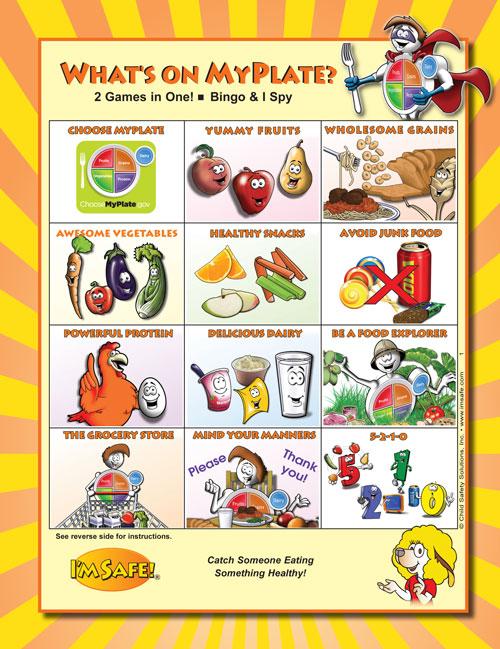Make Healthy Plate Game


Providing healthy meals for their children is the goal of most parents. But with picky eaters, hectic schedules and constantly changing dietary needs and tastes, that can be a difficult task. Many of us are familiar with the food pyramid and the major food groups, but that big chart is cumbersome and at times confusing. That’s why the USDA took the 2010 Dietary Guidelines for Americans and created MyPlate, a new colorful, simple icon that parents can use to develop healthy eating habits for their children and the entire family. “If you take the pyramid and shake it out onto a plate, that’s MyPlate,” says Dr. Robert Post, Deputy Director of the USDA Center for Nutrition Policy and Promotion. Ragnarok Voting System Hack - Free Software And Shareware there. “It’s the same food but shown in a different way.” The need for Americans, especially children, to eat healthy meals is more important than ever.
As Post explains, as of 2007 and 2008, obesity affects 10 percent of children ages 2 to 5, 20 percent of children 6 to 11 and 18 percent of children ages 12 to 19. Here’s how you can use MyPlate to make sure your child is getting everything he needs. Let the Plate Guide You Visit and print out a copy of MyPlate to hang on your fridge, and start building a better plate. Not only does the site break down the food groups in a simple way, it also gives you great tips for a healthy lifestyle. “MyPlate gives you tips to 1) make at least half your grains whole grains; 2) vary your vegetables; 3) focus on fruit; 4) get your calcium-rich foods; 5) find your balance between food and physical activity; and 6) keep food safe to eat. Taken together, this is an attempt to better educate the parent, who is the initial provider of food to the young child,” says Dr.
Chef Solus is excited to tell you what he has learned about the new My Plate! Make your way through all the food groups with these fun games. Blast Off: Food. We also eat more beans because they are inexpensive and have healthy fiber.
Jatinder Bhatia, Professor and Chair of Neonatology at the Medical College of Georgia in Augusta, Georgia. Build a Healthy Plate “We have created food patterns for how you can get your food groups every day,” Post says. “We know that it’s a very good thing, if you don’t get them daily, to think about weekly. Over a week, we hope that you’ve gotten enough of your fruits and vegetables, for example.” This is what your child’s plate should include: • Fruits Fruit includes any fruit or 100 percent fruit juice. Your fruit can be fresh, frozen, canned, dried, whole, cut or pureed.
The goal is to provide your child with vital nutrients such as dietary fiber, folic acid, potassium and vitamin C. Canopus Imaginate 2.0. Fruit can provide all of these without a lot of fat, sodium or calories, and no cholesterol. • Vegetables This group is all about variety and color. Eat a salad, heat up vegetable soup from a can, or order veggies as a side item at a restaurant. Work veggies into your daily routine so they fill more than one-quarter of your plate, leaving the rest of that side of the plate for your fruit.
Choose veggies that are colorful, such as red peppers, dark green spinach, or yellow squash. The USDA also suggests buying your vegetables in season, not only to save on cost but also to maximize the flavor.
They don’t have to be fresh, though, to be good for you. Stock up on canned vegetables (beans, mushrooms, beets), particularly those labeled as reduced or low sodium, as well as frozen vegetables that can be quickly heated. “Parents can use the tips on ChooseMyPlate.gov to learn how to make veggies a good nutritional value and more appealing, and how to keep veggies safe,” Bhatia says.• Protein Foods This group includes both animal (meat, poultry, seafood and eggs) and plant sources (beans, peas, soy products, nuts and seeds). The USDA recommends people ages 9 and older eat 5 to 7 ounces of protein foods each day, including at least 8 ounces of cooked seafood per week.
Opt for lean cuts of meat and poultry, and choose seafood that is rich in omega-3 fatty acids. Also check the sodium levels on processed meats like deli meat and hot dogs so your child does not get too much. “We can get our protein from a variety of sources,” Post says. “We are emphasizing more seafood and accommodating vegans and vegetarians because we recognize it’s not a prescription. It’s about choosing a variety of foods.” • Grains This includes any food made from wheat, rice, oats, barley or other cereal grain.
The goal is to make at least half your grains whole for added health benefits. “Whole grain” simply means that you are eating the entire grain kernel.
You can find whole-grain versions of bread, pasta, cereals, oatmeal and even tortillas. Choose brown and wild rice instead of white. The other half of your grains portion can be refined grains, such as white bread, white rice, grits and pretzels. Oki Microline 280 Elite Printer Driver there.
• Dairy The dairy group has become more inclusive than in the food pyramid days. “Adults who don’t drink milk anymore were confused by the food pyramid,” Post says. “Dairy is more than milk and milk products.